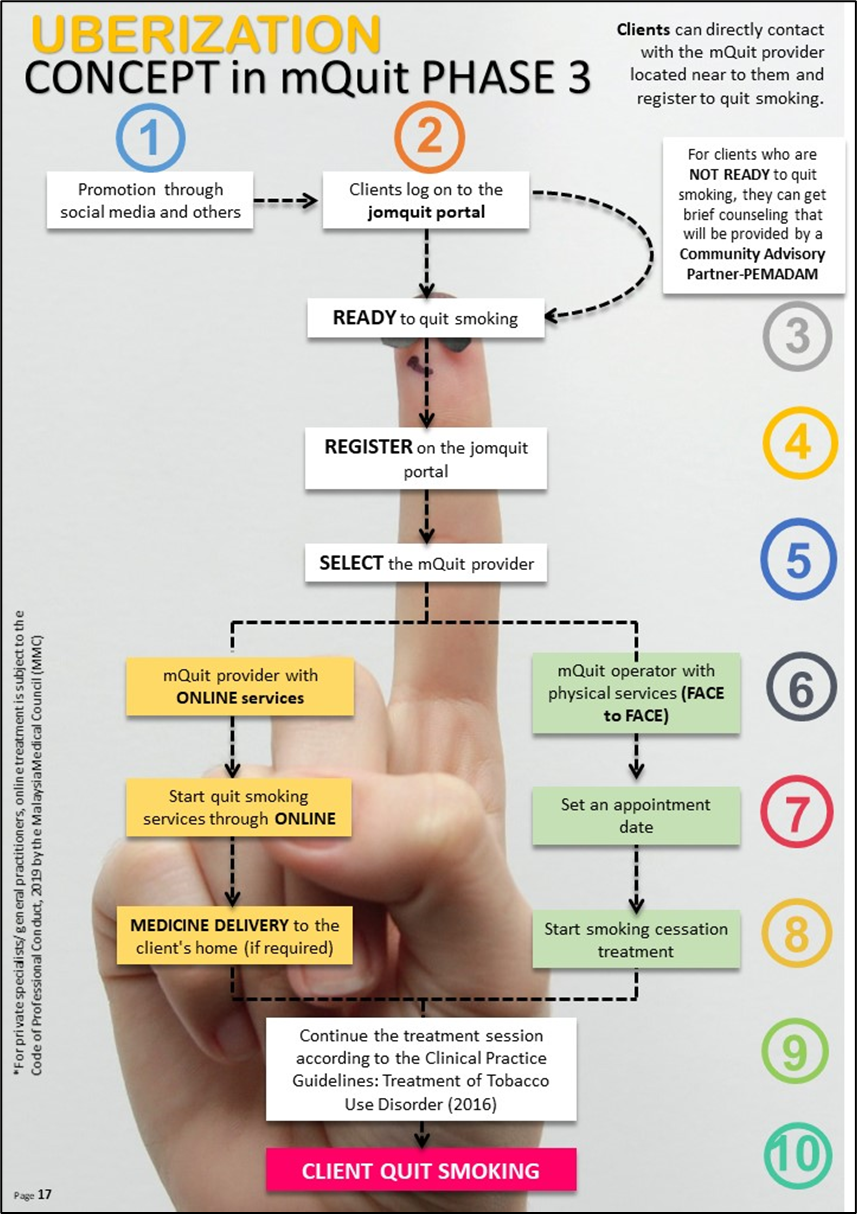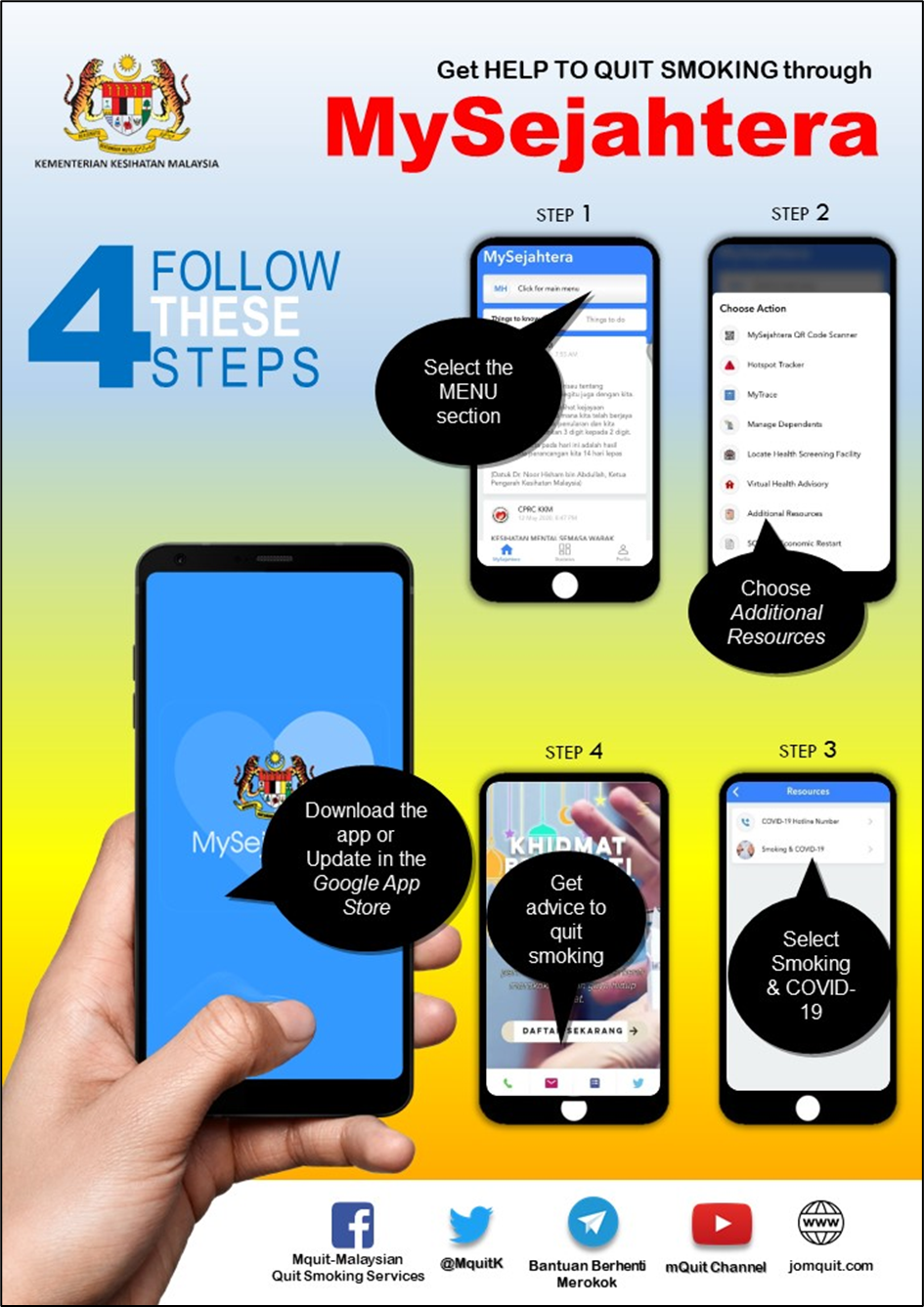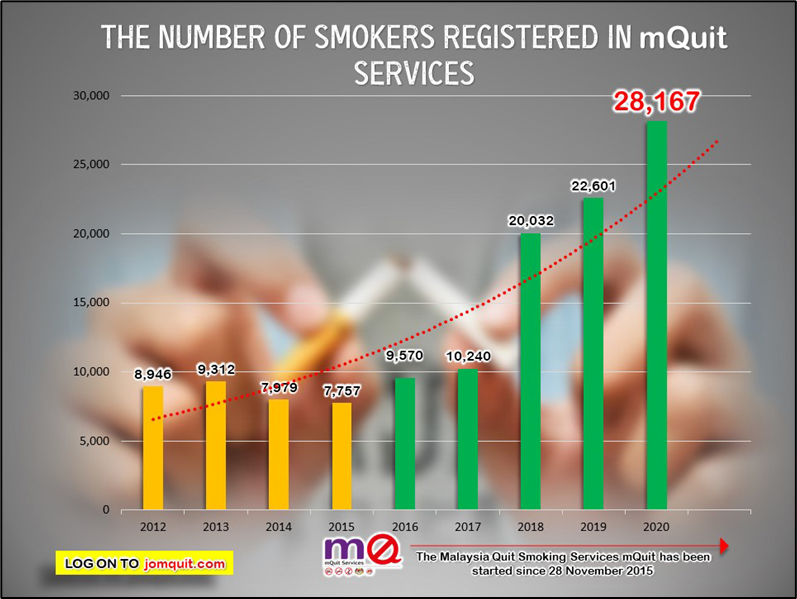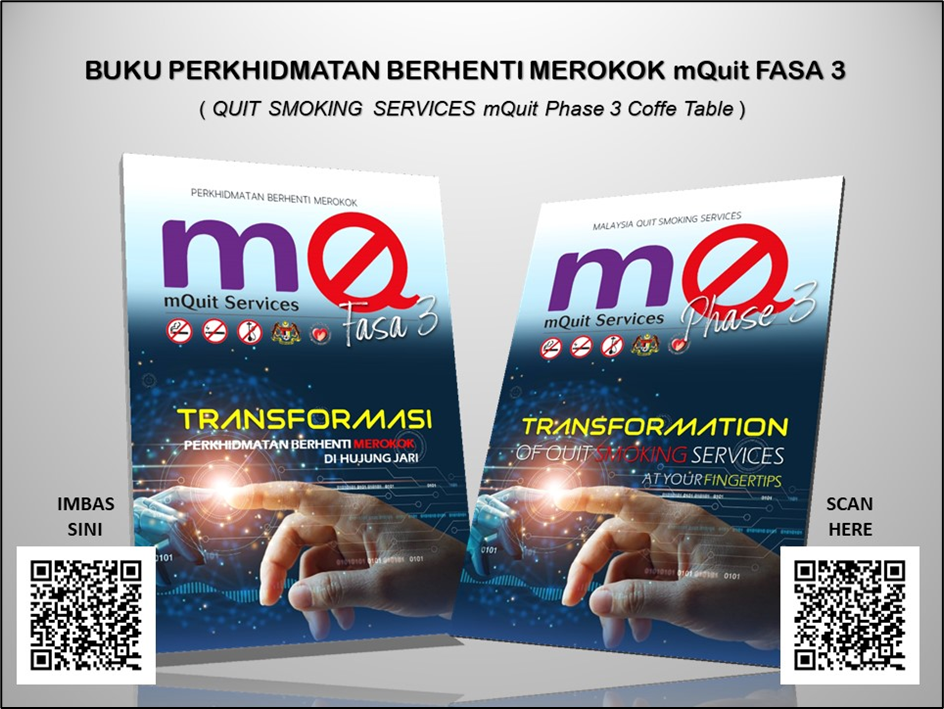World Health Organization Collaborating Centre for Smoking Cessation and Treatment of Tobacco Dependence
Best Practices of Smoking Cessation in the Western Pacific Region
Questionnaire
1. Country / Region
Malaysia
Programme background
2. Name of Programme / Service
Malaysia Quit Smoking Services (mQuit)
3. What was/ were the objective(s) of the programme / service (e.g. triggering quit attempt, promoting new activity, provision of cessation services)?
(answered together with Question 4)
4. What was the duration / time period of the programme / service?
This program was started since 2015 through smart collaboration between Public and Private sector. The 1st phase ran from 2015 until 2017 which aimed to increase number of smokers joining quit smoking services at private facilities. It then proceeded to 2nd Phase in 2017 till 2020 where the services were expanded to workplace area. It enters the 3rd phase on 15 December 2020 which emphasized on Uberization of the services to increase the accessibility especially at remote areas and in line with the new norm of health care services in Malaysia which is via online. This 3rd phase will run from 2020 till 2025.
5. What was the target population?
All current cigarette smokers aged 15 years and above (around 4.7 million based on National Health Morbidity survey (NHMS) 2019) and other smoking products user in Malaysia especially e-cigarette aged 15 years and above (1 million based on NHMS 2019).
Programme details
6. Please briefly describe the activity(-ies) carried out under the programme / service (e.g. provision of smoking cessation services, campaign to promote/enhance cessation services provision).
(Refer to Annex 1).
a. Smokers will need to log on to www.jomquit.com portal to register into mQuit Services.
b. Smokers who yet to quit smoking or the non-smokers who wants to get more information, can proceed to the Community Advisory Partner (run by NGO as a Buddy program ) via chatting or email or telephone calls.
c. Once the smokers are ready to quit smoking, they can register and select the mQuit provider nearest to them (either via online or face to face)
d. For online services: they can start the quit smoking services straight away and medicine will be delivered to their home (if required).
e. For face to face services: smokers can set their appointment date and visit the mQuit provider on the set date
f. Smokers will continue the treatment session according to Clinical Practice Guideline: Treatment of Tobacco Use Disorder (2016).
7. What were the factors that contributed to the programme / service establishment?
a. Smart partnership between Public-Private sector.
b. The accessibility of the services which offers both online and offline services .
c. Wide promotion- especially during this pandemic COVID-19 in which the services are also available via MySejahtera app. (an application used by all Malaysian for the COVID-19 contact tracing) (Refer Annex 2).
8. Did the programme / service involve other organisation(s) (e.g. non-governmental organisation, professional association, academia)? What were their roles?
Malaysia Quit Smoking Services (mQuit) is a smart collaboration between Ministry of Health Malaysia and professional bodies, universities, non governmental organizations (NGO’s) and private sectors. Each partners play their role which grouped into
a. Training
b. Promotion
c. Chain system (via www.jomquit.com)
d. Monitoring and Quality audit
9. Please briefly describe the resource implications for this programme / service:
| i. | How was / were necessary funding and / or manpower secured? |
|---|---|
| mQuit Services were run through Public-Private partnership without any extra financial implications to the Ministry of Health (MOH). Each of the partners will contribute to their own expanses and resources. | |
| ii. | Please briefly describe any use of information technology to implement or facilitate the programme / service |
| This current phase of mQuit Services are run though portal www.jomquit.com where smokers will get brief advice and information on how to quit smoking. Later, when they decide to quit smoking, they will be assisted to register into this program where they will undergo thorough behavioral modification counseling and pharmacotherapy (if needed) by certified counselors via online or offline. The smokers need to pay out of their pocket for this services. | |
| iii. | Any other special resource required to implement the programme / service? |
| Nil. |
10. COVID-19
| i. | Please briefly describe any difficulties encountered during the programme / service implementation amid COVID-19. |
|---|---|
| Majority of smokers in Malaysia were among low household income category (B40) which was 65% based on National Health Morbidity Survey 2019. Their income might be affected especially during pandemic COVID-19, which prevent them to get proper treatment as they need to pay for this service. | |
| ii. | How did you overcome them? |
| MOH is currently in the process of developing the policy for treatment assistance for the B40 category where they will be given special price or subsidize for quit smoking treatment. |
Programme evaluation
11. Was there any evaluation of the programme / service (e.g. quantitative survey, qualitative interview, etc.) conducted?
Annual Ministerial Performance Index (MPI) for quit smoking rate.
12. What was the impact of the programme / services (e.g. number of smokers who quit)?
Number of smokers registered through mQuit services increased every year. The quit rate (number of smokers who were successfully quit over 6 months’ duration) also increased to 50.8% in 2020 as compared to global target for quit rate which was 20%. (Refer Annex 3)
13. How would the evaluation results be used (e.g. improving policy / programmes)?
The quit rate is one of the Ministerial Performance Index (MPI) which used for further development of tobacco control policy in Malaysia.

Figure 1: Flow chart on how smokers can join the mQuit Services Phase 3

Figure 2: mQuit Services also promoted via MySejahtera app (an application used by all Malaysian before they are allowed to enter any premise in Malaysia)

Figure 3: Number of smokers registered to mQuit Services since it was implemented on 28 November 2015
(Kindly downloaded this document for further informations)
